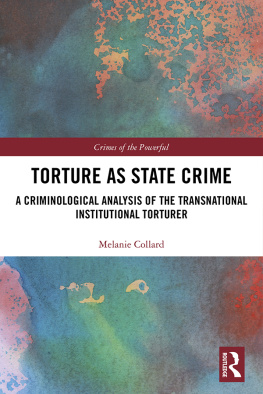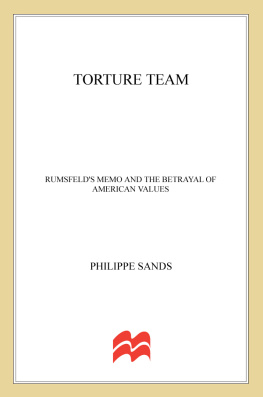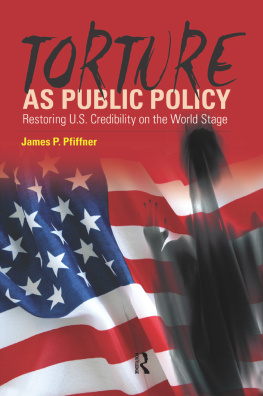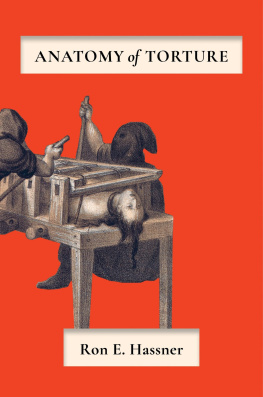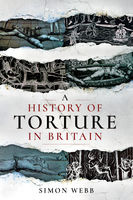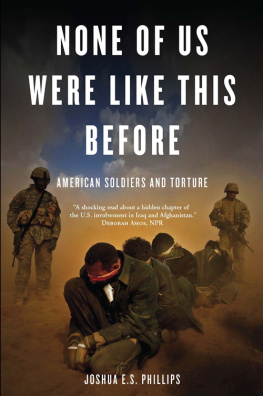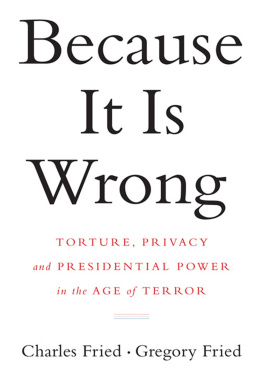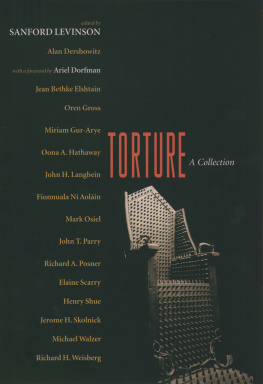American Torture from the Philippines to Iraq

Oxford University Press is a department of the University of Oxford. It furthers the Universitys objective of excellence in research, scholarship, and education by publishing worldwide. Oxford is a registered trade mark of Oxford University Press in the UK and certain other countries.
Published in the United States of America by Oxford University Press
198 Madison Avenue, New York, NY 10016, United States of America.
Oxford University Press 2022
All rights reserved. No part of this publication may be reproduced, stored in a retrieval system, or transmitted, in any form or by any means, without the prior permission in writing of Oxford University Press, or as expressly permitted by law, by license, or under terms agreed with the appropriate reproduction rights organization. Inquiries concerning reproduction outside the scope of the above should be sent to the Rights Department, Oxford University Press, at the address above.
You must not circulate this work in any other form and you must impose this same condition on any acquirer.
Library of Congress Control Number: 2021947725
ISBN 9780197570326
eISBN 9780197570340
DOI: 10.1093/oso/9780197570326.001.0001
Contents
I have accumulated no shortage of debts in writing this book. What follows is only a partial list.
Many of my mentors and colleagues at the University of Washington, my graduate school alma mater, deserve special mention. Beth Kier was the projects first and most consistent champion. Her early encouragement, persistent enthusiasm, and vision proved invaluable. Jon Mercers detailed comments on several underdeveloped drafts, along with plenty of discussion time, improved my work and made graduate school life more enjoyable. I puzzled through the projects ideas with Jamie Mayerfeld, who helped me outline the limits of my arguments and take seriously the ethical implications. Chris Adolph and Jim Caporaso showed me how my approach was more compatible with other perspectives than I had realized. Beth and Jons University of Washington International Security Colloquium (UWISC) was a fantastic atmosphere for trying out ideas, and the UWISC regulars provided excellent feedback when I presented on parts of the project. Following my presentation, a lengthy discussion with Stephan Hamberg helped me clarify the books central claims. Many other colleagues at UW, too numerous to name, had a hand in moving the project forward.
I owe special thanks to archivists at the National Archives, the National Security Archives, and the U.S. Army Heritage and Education Center, as well as the kind hosts that put me up in Washington, D.C., and Carlisle, PA, for many days. Marlea Leljedal and Christopher Einolf sent me materials that I had previously overlooked.
My colleagues at Bates College, where I taught after UW, cheered on my writing progress, and some of the feedback during my job talk there carried over into the final product. Leslie Hill and Stephen Engel showed me how feminist theorizing complemented my explanations. Jim Richter, Jason Scheideman, and Jiyoung Ko kept my mind on international politics, and Nina Hagel fueled me with words of encouragement, professional advice, and baked goods.
The books post-dissertation life got a much-needed boost when Nimah Mazaheri told me to send him the manuscript, refused to take not yet for an answer, and gave me detailed comments. Nimahs advice on this and other projects, plus his generosity as an informal mentor, continues to inspire me. Chris Heurlins assembled student group at Bowdoin, MITs Security Studies Working Group, and Harvards Political Violence Working Group provided additional chances to present and hear back from smart and engaged participants. Annual APSA, MPSA, ISA, and NEPSA meetings left me grateful for discussants and participants insights.
This books finishing touches were completed while on a fellowship funded by the Stanton Foundation at the Harvard Kennedy Schools Belfer Center for Science and International Affairs. A presentation for the International Security Programs seminar series, well-led by Steve Miller and Steve Walt and administered by Susan Lynch, gave me a chance to receive some last-minute suggestions. A follow-up exchange with Averell Schmidt helped me amend the concluding chapter.
I am grateful for Angela Chnapko, Alexcee Bechthold, Saloni Vohra, and their colleagues at Oxford University Press and Newgen Publishing. Two excellent anonymous readers comments improved the manuscript substantially and limited future embarrassments.
My mother and step-father provided encouragement, as did my sisters. My father was a source of inspiration. My mother-in-law and her husband were also in my corner. It was not just verbal support, either; grandparents grandparented the kids so that I could sneak in extra researching and writing time.
The breadth of my debt to my wife Abby is difficult to capturefrom crucial emotional support to writing help to taking the lead on parenting at key moments. She is also jealous of my time and energy in all the best ways, and Im thankful for how she keeps me grounded in family. My children, August and Greta, have shown admirable patience with me. They help me believe that the future is bright and the world worth improving.
The label unthinkable sometimes serves as a synonym for unspeakable, referring to the gruesome nature of the act. McCarthy (2004) writes that even reading or thinking about such practices may make the teeth clench and the stomach churn. It also suggests a perceived mismatch between American moral commitments and torture. Both international and domestic norms proscribe torture. That is, there exists a collective expectation that torture is wrong. Deeply held norms can lend the acts they proscribe an unthinking qualityviolating such taboos does not, or should not, even come to mind (Price and Tennenwald 1996). Critics of the torture program also frequently point out that the United States has a history of treating prisoners well. After the truth of the post-2001 program set in, it prompted a reevaluation. As legal scholars such as Luban (2007, 1425) observed, Torture used to be incompatible with American values. The United States used to punish torturers, sometimes with death (Begala 2009).
While I will contend that the U.S. record of detainee abuse is far from spotless, and the norm against torture is not as robust as it could be, observers of war-on-terror torture were somewhat justified in their surprise. After all, for torture to reach all the way to the twenty-first century in the United States, it had to be remarkably resilient. Torture had to survive the intellectual assault from European Enlightenment authors like Beccaria, who argued persuasively that torture for judicial purposes would generate lots of false confessions. It had to find a way around the founding documents of the United States, which, with strong influence from European thinkers and experience, expressly prohibit cruel and unusual punishment in the Eighth Amendment to the Constitution. Torture persisted despite being prohibited in the American Civil Wars Lieber Code, a forerunner to modern laws of war. It managed to continue beyond the Geneva Conventions from the first half of the twentieth century and the Convention against Torture of 1984. Torture has also endured less legalistic admonishment. The U.S. governments own State Department has been a leading whistleblower for torture and other cruel treatment abroad, with reports so comprehensive that scholars have used them to construct torture variables for quantitative analysis. This book asks the following: Why has torture recurred, and in particular why have torture and the norm against it persisted in tandem like undying rivals for over a century?


